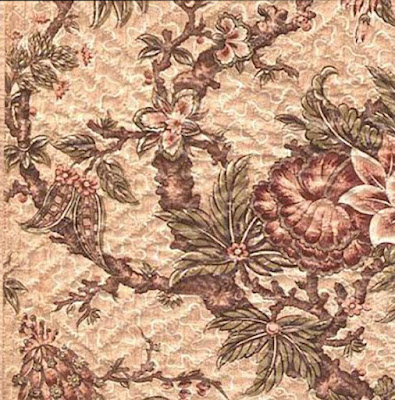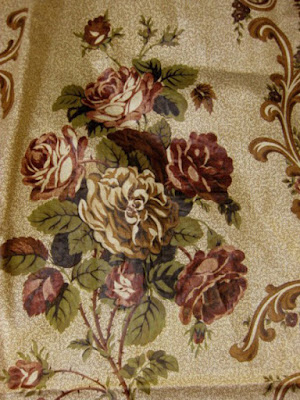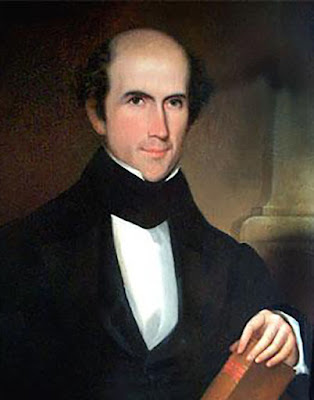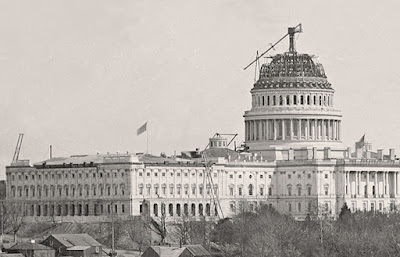Quilt associated with Martha Elizabeth Harris Harris,
Leonardtown, Maryland, 1830s.
The D.A.R. Museum showed this star quilt in their
Eye on Elegance exhibit several years ago. It's also pictured in the book
A Maryland Album.https://eyeonelegance.dar.org/node/50
Pieced of three prints, the bedcover reflects the elegance of life in aristocratic Maryland family.
Martha married her third cousin Benjamin Gwinn Harris in 1826
(the occasion for which the quilt was made?) and moved into his
childhood home known as Ellenborough. Her sister Catherine Ruth married
Benjamin's brother Henry Reeder Harris.
The border print is an "Arborescent chintz" (gnarly tree branches
were popular in the first decades of the 19th century.) The background
is what was called a "Fancy Machine Ground," adding more pattern to a busy print.
The chintz offers a contrast to the simpler nine-patch star repeat, a sort of transition in taste between patchwork of furnishing fabrics and the coming trend for calicoes.

Another large-scale print on the reverse features a rococo scroll and roses with a Fancy Machine Ground.
Yardage of the same print.
Martha Elizabeth Harris Harris (1814-1892)
Maryland Historical Society
This painting of Martha is a copy of an original by George Cook done in 1839.
Maryland Historical Society
Benjamin Gwinn Harris (1805-1895) by George Cook
Harris was an attorney and politician.
Their daughters Ann Delia Harris and Susan Ruth Harris Maddox
The 1850 census gives us a glimpse of the household at Ellenborough. Benjamin's biographer Joshua E. Kastenberg noted their property was valued higher than any other in St. Mary's County with 45 enslaved laborers. Ann Delia was at home but Susan may have been at school. Others may be relatives including Emily Long at 45 listed as Insane and a Pauper.
When the Civil War began Martha was in her mid 40s with two grown girls; Susan was married to George F. Maddox. Benjamin had become a spokesman for Southern secession in a polarized Maryland. He'd given an indication of his political and personal opinions in a failed 1858 petition to the Maryland Legislature to re-enslave the state's 80,000 freed people. Maryland remained in the Union but many of his neighbors were sympathetic to the Confederate cause. In 1863 he was elected to the U.S. Congress to represent the southernmost Maryland counties.
The 38th Congress
Aggressive in his defense of secessionist rights and Black inferiority he alienated fellow Democrats (to say nothing of the Union-sympathizing Republicans) with his "Furious Speech." During the Democrat's convention nominating George McClellan he knocked down a fellow delegate.
The Capitol During the War
Library of Congress
A motion to expel him was introduced in Congress a year before the war ended but the two-thirds majority vote could not be reached so he continued in his position. He was censured as an "unworthy member" who had shown "gross disrespect" for the House of Representatives. Every time he began to give a speech the censure was read. After Lincoln's assassination he referred to John Wilkes Booth as a patriot.
Harper's Weekly, 1863
Copperheads---Union residents with Confederate sympathies
Many suspected Harris of assisting Confederates passing through St. Mary's County during the war. The lingering desire for consequences for his "Copperhead" actions continued after Appomattox when a small gesture of generosity to two ex-Confederate soldiers resulted in his arrest and conviction for treason in aiding and comforting the enemy. Imprisoned in Washington in May, 1865, he went out for walks everyday with former Confederates and visits with wife Martha. After a few weeks President Andrew Johnson paroled him.
Benjamin returned to Ellensborough where he and Martha lived until the end of the century. His vicious political maneuvers continued with an unsuccessful run for Congress on a platform voiding the antislavery 14th & 15th Amendments and removing all Congressmen of African-American descent.
The 1880 census found Martha and Benjamin living with daughters Delia and a widowed Susan and her three girls plus three African-American servants, John Dorsey, Olivia Coale and her ten-year-old son William. Harris had one bad idea for solving their post-war economic problems, asking Congress to reimburse former slave owners for the loss of their human property, another failed political move.
This 1895 obituary in the Buffalo Courier summarizes
the career of a "very bitter" man.
We unfortunately hear too much of her husband's voice and not much of Martha's, but she did leave a diary from 1850-1891 in the Maryland Historical Society (now The Maryland Center for History and Culture), as yet undigitized. See Mrs. Benjamin Gwinn Harris Diary.

We can digress from demagogues to quilts. Here's a second quilt
from perhaps 1825 to 1850 with the same print in the border.
Pictures from an online auction
The star blocks are the same pattern as the D.A.R.'s quilt
although the set is different.
A mysterious coincidence.
Same maker?
Regional style?





















1 comment:
What a story. Slavery was and still is a terrible mark of our history. Im sure others felt as this man did. Lincoln was a Great President. Thank you for all your history, both the good and the bad. The block is interesting. The blocks look to be the same color. I do like the simple nine patch star repeat but I may change the colors. We have such lovely fabrics now.
Post a Comment